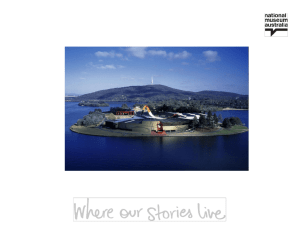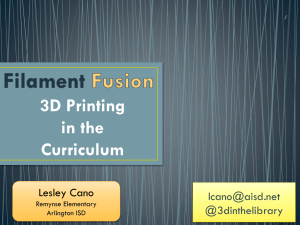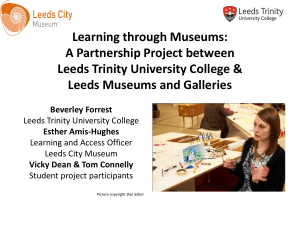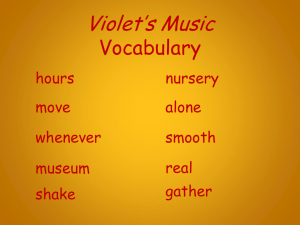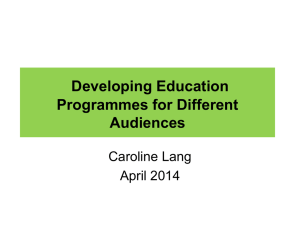A Design Study of Integrating Mobile Learning in a Museum into a
advertisement
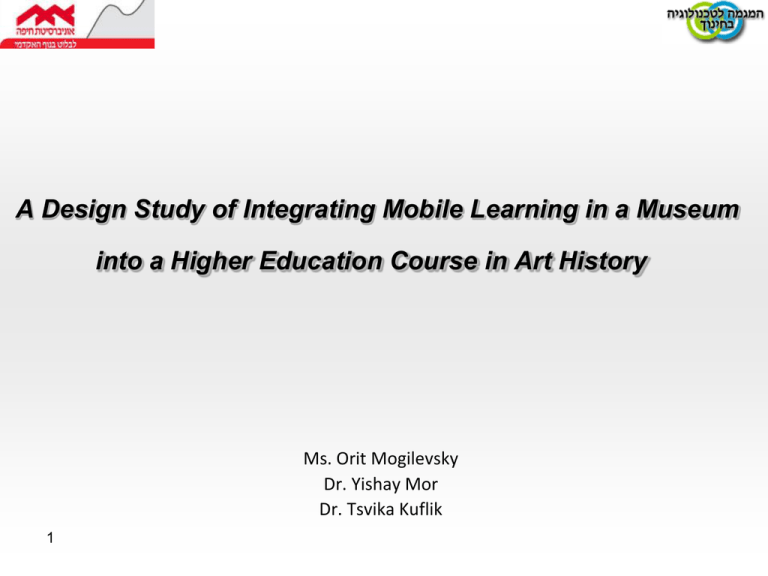
A Design Study of Integrating Mobile Learning in a Museum into a Higher Education Course in Art History Ms. Orit Mogilevsky Dr. Yishay Mor Dr. Tsvika Kuflik 1 A Design Study of Integrating Mobile Learning in a Museum into a Higher Education Course in Art History Ms. Orit Mogilevsky Dr. Yishay Mor Dr. Tsvika Kuflik 2 The challenge The Challenge • Studies addressed the issue of promoting learning by enabling students to work autonomously, creating activities that encourage active, collaborative, challenging, enriching learning experience and encouraging students to develop their social and cultural capital (Zepke & Leach, 2010). • However, the structure of existing educational systems impede university teachers from incorporating these approaches in their teaching methods (Dunlap & Grabinger, 1996). 3 Learning in museums Possible Solution: Museums near universities provide opportunities for enhancing learning in higher education. Why museums? • Museums offer long-term learning opportunities by enabling educational projects which connect learners’ formal classroom education and informal out-of-school learning, thus making museum displays more enjoyable and motivating for learning (Sung, 2010) • Museums form a fertile ground for an active learning environment that advances exploration and discovery; the exhibitions display a variety of themes and objects that constitute an ideal setting for inquiry and engagement (Vavoula, 2009). 4 Learning in museums Another Challenge: There is little cooperation between museums and universities • Museums offer only few resources and services for higher education students, whereas they show more collaboration with school age children (Anderson,1997). • Universities rarely exploit museum learning opportunities they encounter and combine it into the curriculum (Cook et al, 2010). Museums 5 Universities Mobile Learning in museums The Solution • Use mobile technology to support the integration of museum visits into an academic learning curriculum. Thus, enabling an autonomous, rich and immersive experience that will enhance the current academic learning structures. Why mobile technology? • Mobile technology allows designing learning that is open and experiential, as well as structured and directed (Sharples, 2007). • In the context of museums (Wessel & Mayer, 2007) : * Mobile technology may provide the visitor attentional focus and guidance during the visit * It can be used to draw attention to significant exhibits * Presents adapted information to a specific visitor * Helps in navigation 6 * Enrich and expand the social interaction. Research Questions Research Questions: Main Question: • How does the integration of mobile learning in a museum into a higher education course influence both the academic learning experience and the museum learning experience? 7 Research Questions • What are the challenges in teaching a course of art history that includes museum visits? • In what ways can mobile technology enhance the learning of art history during a museum visit? 8 Methods Research Method: Design Based Research • The design-based research methodology illustrate how, when and why a successful educational innovation works in practice. Thus, it bridges the theoretical research and educational practice. • The design methods in the study include learner-centered methods and participatory design for the development of scenarios and prototypes • Students' needs will be identified for the purpose of applying the appropriate learning activity. • This study adopts an ethnographic user modeling approach, which perceives human activity as part of a whole of social and cultural contexts in order to capture an accurate picture of the learning context . 9 Research Questions • What are the challenges in teaching a course of art history that includes museum visits? • In what ways can mobile technology enhance the learning of art history during a museum visit? 10 Findings Current situation Students are learning in the classroom After one week 11 Next week we are going to Hecht museum to learn about “Amarna relieves” Here are the relieves, Look at their artistic style Findings • What are the challenges in teaching a course of art history that includes museum visits? Enabling students to work A dearth of published information about pedagogy and assessment in the discipline of art history (Donahue-Wallace et al, 2008) Autonomously. active, collaborative and Challenging learning experience. Linking between classroom learning and museum learning 12 Research Questions • What are the challenges in teaching a course of art history that includes museum visits? • In what ways can mobile technology enhance the learning of art history during a museum visit? 13 Findings Scenario: Art history students using mobile technology in the museum Students are learning in the classroom Next week we are going to Hecht museum to learn about “Amarna relieves” How do the themes and motifs on the relieves reflect Egyptian cults? 14 Egypt Egypt Hecht- Museum guide Findings At the end of the presentation The students get a mission: A problem to solve and answer to questions Send the picture with the answer to a website The student writes answers to the questions This is a unique This is a unique artistic style… artistic style… Send to: url 15 The student is taking a picture of a relief The students and the teacher can see together in the class the answers in the website and discuss about it. I can see it also in my laptop 16 This is a unique artistic style… This is a relief from Amarna Findings In what ways can mobile technology enhance the learning of art history during a museum visit? Enabling students to work A dearth of published information about pedagogy and assessment in the discipline of art history (Donahue-Wallace et al, 2008) Autonomously. active, collaborative and Challenging learning experience. Linking between classroom learning and museum learning 17 Future work Future Work How to design a mobile learning environment for a course in art history that connects between learning in class and learning within the museum and provides learning experience based on active and cooperative learning principles? 18 Future work •A detailed scenario will be presented to the lecturer and the students •Their feedback will be calibrated with findings from the literature, as a basis for the next round of design •The learning environment will be developed and evaluated in real-world settings. 19 Thank you! orit.mogilevsky@edtech.haifa.ac.il http://sites.edtech.haifa.ac.il/oritiresearch/ 20

